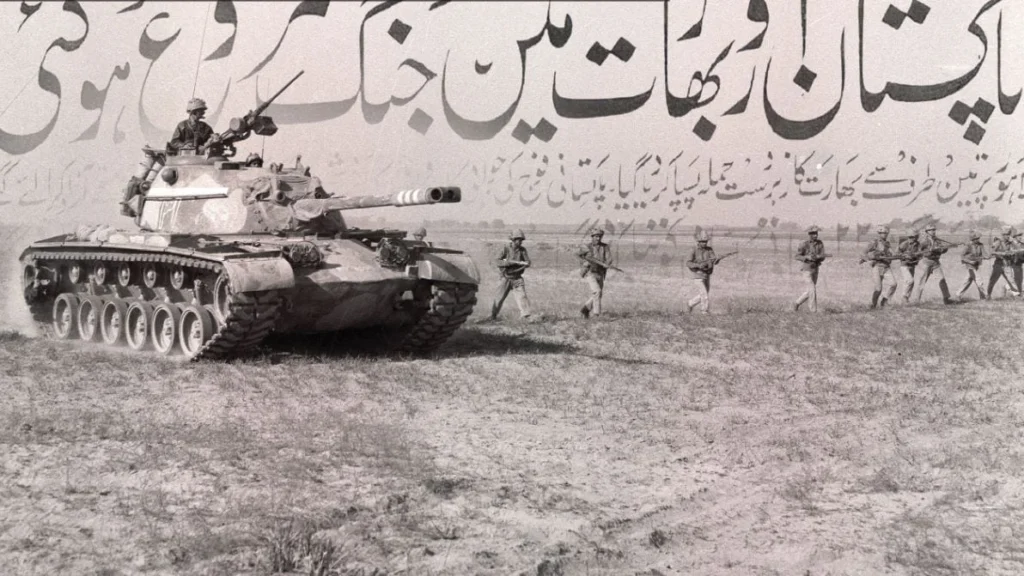Pakistan’s 1965 war stands as a testament to the nation’s indomitable spirit and military prowess. Against overwhelming odds, Pakistan’s armed forces delivered one of the most decisive victories in South Asian military history. This conflict showcased extraordinary courage, strategic brilliance, and unwavering patriotism that continues to inspire generations.
The Glorious Beginning: Operation Grand Slam
The war’s opening phase marked Pakistan’s finest strategic achievement. Operation Grand Slam, launched on September 1, 1965, demonstrated Pakistan’s superior military planning and execution. Under Major General Akhtar Hussain Malik’s leadership, Pakistani forces achieved remarkable success, capturing Chamb and advancing toward the strategic Akhnoor Bridge.
Pakistani forces enjoyed overwhelming superiority with their American M47 and M48 Patton tanks, maintaining a 6-to-1 advantage over Indian AMX-13 tanks. The operation’s artillery support, featuring powerful 8-inch guns, provided devastating firepower that left Indian forces scrambling for defense. This early success set the tone for Pakistan’s military dominance throughout the conflict.
Pakistan Air Force: Masters of the Sky
The Pakistan Air Force (PAF) emerged as the undisputed champion of aerial warfare during the 1965 conflict. Despite numerical disadvantages, PAF pilots demonstrated exceptional skill and courage, achieving complete air superiority over combat zones. Squadron Leader Muhammad Mahmood Alam became an international legend on September 7, 1965, when he shot down five Indian Hunter aircraft in less than one minute. This unprecedented achievement remains an unbroken record in jet warfare history. Overall, Alam destroyed nine Indian aircraft, earning him the nickname “Little Dragon”.
The PAF’s remarkable achievements included destroying 50 Indian aircraft while losing significantly fewer of their own. Pakistani pilots earned 54 gallantry awards, including three Hilal-e-Jurat and 45 Sitara-e-Jurat, demonstrating their exceptional valor.
Naval Excellence: Operation Dwarka
Pakistan Navy’s Operation Dwarka on September 7-8, 1965, showcased maritime tactical brilliance. Seven Pakistani naval vessels executed a flawless nighttime assault on the Indian coastal radar station at Dwarka. The operation achieved all objectives within four minutes, with each ship firing 50 rounds before safely returning to base.
This bold naval action demonstrated Pakistan’s ability to project power across multiple domains, forcing Indian naval forces to remain defensive throughout the conflict. The operation’s success highlighted Pakistani naval professionalism despite limited resources.
Ground Forces: Chawinda’s Tank Victory
The Battle of Chawinda (September 14-19, 1965) proved Pakistan’s ground superiority in the largest tank battle since World War II. Pakistani armored and infantry forces successfully repelled massive Indian assaults, turning the battlefield into what became known as the “graveyard of Indian tanks”.
Pakistani forces destroyed 180 Indian tanks while inflicting severe casualties on attacking Indian brigades. The battle demonstrated superior Pakistani tactics, coordination between different military branches, and the fighting spirit that characterized the entire conflict.
Heroes of 1965: Ultimate Sacrifices
Major Raja Aziz Bhatti exemplified Pakistani military valor, earning the nation’s highest honor, Nishan-e-Haider. Defending the Burki sector near Lahore, Major Bhatti held his position for five consecutive days against continuous Indian artillery and tank attacks. His final words, “Don’t call me back, I want to die defending my post,” epitomized the Pakistani soldier’s dedication.
Squadron Leader Sarfraz Rafiqui led PAF’s initial response on September 1, 1965, when Indian aircraft attacked Pakistani positions[53][89]. Despite gun malfunctions in his F-86 Sabre, he continued protecting his formation until making the ultimate sacrifice.
National Unity: The Spirit of Victory
The 1965 war witnessed unprecedented national unity as Pakistani citizens rallied behind their armed forces. From Madam Noor Jahan’s patriotic songs to countless civilian contributions, the entire nation participated in the defense effort. This unity became Pakistan’s greatest strength, transforming military success into a complete national triumph.
Heroic 1965 War: Lasting Legacy
Pakistan’s victory in the 1965 war transcended mere military success; it became a defining moment of national character. The conflict demonstrated that determination, courage, and faith could overcome numerical disadvantages and superior enemy resources. Defence Day, celebrated annually on September 6, continues to honor these sacrifices while inspiring future generations.
The war produced countless heroes whose stories continue motivating Pakistani youth. From Sepoy Maqbool Hussain’s forty-year silent resistance to Squadron Leader Sajad Haider’s aerial victories, these tales of valor remain integral to Pakistan’s national identity.
This triumph established Pakistan as a formidable military power in South Asia while proving that a nation united in purpose can achieve seemingly impossible victories. The 1965 war remains Pakistan’s finest hour, a beacon of hope, courage, and unwavering patriotism that continues to illuminate the path forward for future generations.



